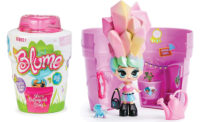Roll printing and converting industries have struggled for years with material handling methods. Plastic film/tube/bag extruders and web label printers all face the material handling issues daily. Safety risks and product damage are the top concerns. Large and small rolls historically pose safety risks because of their round shape, heavy weights, slick surfaces and top-heavy unstable stacking for storage. Other converting industries (like sheet fed folding carton) have found the answer, and we propose commitment to a simple and revolutionary principle of driving all material handling practices toward keeping your substrate in the same orientation for storage and handling as processing. In the case of flexible packaging it starts with rolls "Eye to the Wall."
The “eye” for purposes of this discussion is the core of the roll, or web. “Eye to the Wall” means the rolls are in the horizontal rolling position and the core holes are facing the walls. The ninety degree opposite “Eye to the Sky” orientation has most often been used to maximize storage space utilization. People will stack and remove rolls with a clamp truck in a vertical orientation.
It all makes sense to think in terms of bringing the raw material to printing and converting machines ready to be placed directly into an unwind and taken away in a similar fashion. Significant improvements can be made that will reduce accepted waste and awkward changes at the wind/unwind of printing and converting machines. Are you accepting the loss of more wraps on a roll prior to processing as a necessary evil because it is the only way to ensure getting past the damage caused by prior handling? What about slower than optimum changes from one roll to the next? The end in mind that will drive us to excellence is striving for maximum safe efficient storage and transportation of rolls in your roll producing and converting plants.
Eye to the Sky vs. Eye to the Wall
Vertical stacking of rolls and the extensive use of roll clamp trucks for positioning/stacking and removing the rolls is often embraced because it provides the maximum use of the space in an unimproved warehouse setting. In the event there is access to standard pallet racks, trying to put cylindrical loads in cubed rack storage spaces makes less sense. Round pegs in square holes is never a good idea. So a major pro for stacking rolls vertically Eye to the Sky is space utilization.
On the con side of Eye to the Sky storage and Handling:
- The roll clamps do great damage to the rolls resulting is more waste during processing; the rolls must be taken down and then flipped to a horizontal orientation for processing in an awkward dance between the clamp truck and a pallet for delivery to the press.
- They are actually rolling on the floor to pick up contamination that has a good chance of getting into the machine resulting in imperfections of print or cutting and more outer wrap damage that must be removed.
- Safety can be a huge concern because the movement of these rolls from high in the sky with clamps is precarious.
- Manual tipping using a pipe in the core along with manual positioning of the rolls in the unwind can be dangerous.
Eye to the Wall handling presents sets of challenges, too. On the con side, it requires special storage and handling devices to allow this elegant method to functional fully and seamlessly. In some operations, portions of this methodology can be implemented quickly while other aspects of the concept must be worked in as time and money permits. Standard pallet racks sometimes might work and other times are not appropriate for the horizontal rolling position storage.
It is best to look at the handling systems, storage, and methods from the ground up and adapt and purchase racks and unwinds according to the base platform used for delivering the rolls to and taking them away from the equipment. The pictured high density flow rack system is an example of a rack system designed for storing and dispensing work in process rolls while maximizing space utilization. Other types of systems include high rise drive-in or selective rack systems with wire guided or automatic retrieval vehicles. There is a wide range of options from a financial perspective. Planning is the key.
Once the storage methods have been agreed upon and implemented then the smooth transportation of rolls on specially designed heavy duty cradle style plastic or metal pallets becomes smooth and safe. The reduction of up and downs, grasping with clamps, tipping and rolling all result in time, safety, hygiene, and product damage improvements.
Stratis Pallets & Bonar Plastics brands of Snyder Industries, Inc.
(402) 467-5221
www.PALLETS.com





